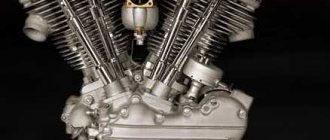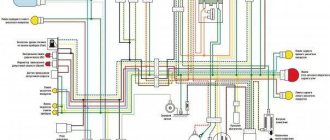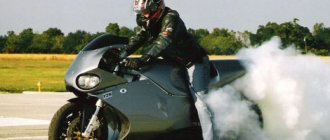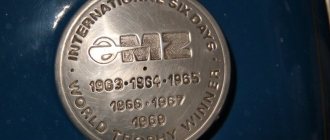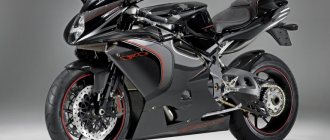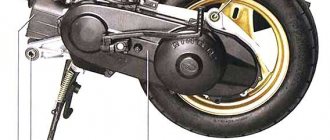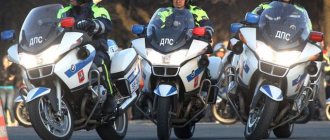Model class : touring enduro.
Years of production/sales: 1993-1999
The BMW R1100GS was first presented in September 1993 at the IAA in Frankfurt and replaced the BMW R100GS. Simultaneously with the R1100GS model, the R1100R was developed, built on a common base, chassis and engine with the GS. The abbreviation GS stands for Gelände/Straße - a universal motorcycle suitable for traveling on roads of any quality.
The basis for the BMW R1100GS was an air-oil-cooled 2-cylinder boxer engine with a volume of 1085 cc and producing 80 hp. power and 97 Nm of torque. For the German market there was also a “smothered” version with 78 hp. – it was purchased by those who wanted to save on insurance.
In 1998, based on the BMW R1100GS, a younger model was built - the BMW R850GS, which existed until 2001.
Other features of the BMW R1100GS include a steel frame, 5-speed gearbox, spoked wheels, proprietary Telelever and Paralever suspensions, cardan drive, disc brakes with ABS (optional), heated grips (optional) and 243 kg curb weight.
An interesting feature of the BMW R1100GS is also the fuel tank. Models were produced with both a plastic and metal tank. The plastic one had a nominal capacity of 25 liters, and the metal one - 24 liters. However, both of these tanks held the same amount of fuel - 24 liters. The 25-liter plastic tank, although it had a nominally larger volume, due to design features could not be filled above 24 liters.
The BMW R1100GS model was produced until 1999, after which it was replaced by the BMW R1150GS. A total of 43,596 R1100GS units were produced, of which almost half (21,800 units) were sold in Germany.
Specifications
Technical characteristics of BMW R1100GS:
| Model | BMW R1100GS |
| Motorcycle type | touring enduro |
| Year of issue | 1993-1999 |
| Frame | steel 3-section |
| engine's type | 2-cylinder 4-stroke boxer (Boxer) |
| Working volume | 1085 cc |
| Bore x Stroke | 99x70.5 mm |
| Compression ratio | 10.3:1 |
| Cooling | air-oil |
| Number of valves | 4 valves per cylinder, 1 camshaft per cylinder head |
| Fuel supply system | injector Bosch Motronic MA 2.2 |
| Ignition type | electronic |
| Maximum power | 80 hp at 6750 rpm |
| Maximum torque | 97 Nm at 5250 rpm |
| Transmission | 5-speed |
| type of drive | cardan |
| Front tire size | 110/80-19 |
| Rear tire size | 150/70-17 |
| Front brakes | 2 discs, 305 mm, 4-piston calipers (optional ABS) |
| Rear brakes | 1 disc, 276 mm, 2-piston caliper (optional ABS) |
| Front suspension | BMW Telelever (preload adjustment), stroke - 190 mm |
| Rear suspension | pendulum BMW Paralever (preload and rebound adjustment), stroke - 200 mm |
| Overall dimensions (LxWxH) | 2189x920x1366 mm |
| Seat height | 840-860 mm (adjustable) |
| Gas tank capacity | 24 l (including reserve - 4.7 l) |
| Maximum speed | 195 km/h |
| Acceleration to 100 km/h (0-100) | 4.3 sec |
| Motorcycle weight (curb) | 243 kg |
The season is over, the New Year is just around the corner and it seems to me that it’s time to sum up the results of the first year of riding a new motorcycle. So, R1100GS, simply put, “Goose”. The mileage this season is 12,000 km. In the beginning, I was quite careful about how I felt. Still, the device is noticeably more powerful and somewhat heavier than my old TA600. And when you stand next to him, he seems simply huge! But after the first 3000 km, I almost got used to it. So much so that he began to actively use row spacing in the city and feel much more confident on dirt roads outside of it.
I tested the motorcycle on several relatively long trips. I will say that I felt it right away: the power of the motorcycle and its weight added positive sensations. Cruising speed - the one at which it is comfortable to drive constantly, without thinking, has increased by about 20 km/h. That is, if earlier I was forced to “hold” 120 km/h, periodically sliding down to 100, now everything works out by itself.
Further. Despite the fact that the motorcycle is quite large, and in profile it is quite large, the side wind stopped bothering me in open areas. I mean, no, of course I feel it, but unlike riding the Transalpa, it doesn’t bother me at all. Doesn’t rearrange, doesn’t force you to reduce speed to reduce drift.
Control comfort. The wide handlebar and seating position make the handling somewhat “lazy” and somewhat reminiscent of a large ship. I moved the helm a little and it smoothly, without sudden movements, but very confidently (and you can feel it) changes tack. At the same time, if you need to drive aggressively, turning the engine a little higher than usual, everything happens as it should, but again, calmly and confidently. The instrument panel is convenient and more than informative. Especially after I introduced RID (rider information display) into it, which displays the engine temperature, fuel level, gear number and time.
I was also pleased with the stock heated grips. Two modes, one “warm” and the other “hot” allowed me to ride comfortably almost until the end of November.
Landing. On my vehicle, the stock seat is quite noticeably lowered (apparently by the first owner). Not to say it’s mega-convenient, but tolerable. And yet I will make it a little higher (i.e., closer to the original height), especially since there is a need to update the seat cover - the old one is torn. The passenger, as I understand it, is also happy with everything and cheerfully sleeps on his segment of the seat (it is composite) almost the entire way.
By the way, about driving with a passenger . If its weight does not exceed 55 kg, then the motorcycle does not seem to feel it. Or rather, of course, it feels that there is a person behind, but this does not affect the handling at all. If the passenger weighs more, then all the same, the control changes within reason.
About the same can be said about riding with full panniers - neither the dynamics nor the behavior of the motorcycle practically changes. There is a feeling that he is like a big iron iron - he rushes to himself and doesn’t care about anything.
Regarding “how much and how he rushes/eats”, there are also fully formed impressions. The heaviness and large volume are very helpful when driving over graders. A heavy motorcycle, capable of braking quite effectively with its engine, turned out to be very controllable on the dry graders of the Kola Peninsula and Karelia. Transalp chattered a little louder. Compared to the TA, even on much more asphalt tires (Metzeler Tourance), the result was more than pleasant.
Brakes. To effectively stop a 245 kg colossus (this is without passengers and cargo), they must be quite powerful. Two 4-piston Brembo calipers at the front and one 2-piston at the rear do the job quite well. And coupled with the ABS system (quite primitive, but working quite well), the brakes become simply fabulous. No matter how hard I tried, I couldn’t get the rear wheel to skid—the motorcycle just stopped straight.
Suspension. At the front, the so-called “teleever” design is very successful; there is no trace of any “dive effect” when braking. Management is clear and predictable. The rear “paralever” also has sufficient torsional rigidity, but I would still, ideally, change the shock absorber spring to a “stiffer” one. When you're driving alone it's okay, but with a passenger and cargo the spring is a bit weak - you have to tighten the preload knob all the way. Otherwise it breaks.
the appetite of a fuel-injected boxer engine more than moderate - up to 90 km/h about 5 liters/100 km, after about 5.3-5.4 liters, over 140 - about 6 and a kopecks. Considering that the average volume of gasoline poured without taking into account the remainder, which is always floundering there, I had approximately 17-19 liters per 350 km of run, and my tank is plastic, it is larger than the metal one that was used in later versions, the engine consumes an average of 5 ,3l at a speed range from 80 to 140 km/h. It can be faster, but why?
More about the engine. It has air-oil cooling and therefore operates at a rather intense operating temperature. This doesn’t interfere with life at all, but I noticed that in the summer, in the heat, or from pushing for a long time in the aisles, the engine heats up by more than half the scale and its sound changes. He begins to tap, as it were. But as soon as the temperature drops, everything is normal again.
About sounds . In general, “Goose” makes a lot of different sounds. It knocks, clangs, creaks, clinks and rustles. At first, I constantly thought that something was faulty and would break, but then experienced goose breeders convinced me that this was how it should be. Over time, I stopped paying attention to these sounds.
Light. Reasonably sufficient. I use a standard square headlight with a regular H4 OSRAM halogen. I also installed an LED additional light under the “beak”, but I mainly use it to identify myself in the daytime. It is not necessary to use LEDs - you can also use halogens; the powerful 700 Watt generator will easily power any lamps.
Ergonomics of controls . At first, controlling the light was quite unusual, especially the turn signals - they each turn on with their own hands. But, after a fairly short time, I got used to it and no longer paid attention to it. By the way, I discovered a very interesting point: in order to blink the emergency lights at the rear driver (for example, to thank him for giving way), you just need to simultaneously hold down both turn signal keys. If you then suddenly release them, both turn signals will also go out simultaneously. Comfortable. The remaining keys on the steering panels are also located very conveniently and thoughtfully. What you have to work with constantly is accessible very easily, with the slightest movement of a finger, and on the contrary, what is not needed on the go - for example, the starter button and especially the engine shutdown lever - is located so that they cannot be accidentally touched, simply because there is no reach out
The rest of the motorcycle's controls - the brake and clutch levers, the gear shift lever and the rear brake pedal - are ordinary, not very rigid, but enough to not wobble and provide comfortable control. Perhaps only the rear brake pedal has a very small area, but I got used to it.
Further. Maintenance and repair. At least the one that happened in my situation. In terms of maintenance, everything is quite simple: 20W50 mineral water in the engine, 250g and 1 liter of transmission in the axle and gearbox, respectively. Air and oil filters are not expensive and are quite accessible. So are the brake pads. Even the Chinese on Aliexpress sell the latter as a set very inexpensively. The quality is quite normal, they just whistle a little when wet. And unlike European ones, they do not have springs in the hole for the guide. But this does not affect braking in any way. And the price tag is nice. You also need to change the fuel filter, but I haven’t done this yet, so I won’t write about it yet.
I discovered an interesting point - the motorcycle runs smoother and works better with Japanese NGK spark plugs than with the original Bosch spark plugs ordered from Germany. I can’t name the reason; I don’t understand it myself. But I drive German ones as spares.
Now for the renovation. Since the motorcycle is not very new (20 years old already) and apparently has been standing for a long time, many things had to be, so to speak, thoroughly serviced. The following were replaced : 1) fork seals/anthers (flowed like a stream) 2) battery 3) Pads all around 4) Old rubber brake hoses with reinforced ones 5) Headlight lens glass (Japanese shines in the other direction) 6) All calipers were completely rebuilt, and The rear one even had new pistons machined. 7) The hall sensor cable was replaced with high-temperature wires. The cuff between the rear axle and the cardan casing 9) The lamp in the headlight (the low beam spiral burned out) 10) Oil and oil filter.
7) The hall sensor cable was replaced with high-temperature wires. The cuff between the rear axle and the cardan casing 9) The lamp in the headlight (the low beam spiral burned out) 10) Oil and oil filter.
I can say for sure that, contrary to popular belief, the cost of all these parts was exactly the same as the cost of similar ones for a Japanese motorcycle. And some things were found from third-party manufacturers and cheaper.
Ahead of me is adjusting the valve clearances, replacing the air filter, a new change of pads and most likely tires. Well, and also a pleasant fuss about installing the tuning purchased over the summer and autumn, putting in order minor defects that I simply forgot about in the summer. It was necessary to travel.
Summary: based on the results of the first season on the Gus 1100, I am SATISFIED with the motorcycle.


